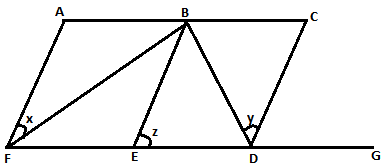11th And 12th > Mathematics
SOLUTION OF TRIANGLES MCQs
Total Questions : 15
| Page 1 of 2 pages
Answer: Option A. ->
0
:
A
Let’s construct the lines and angles which constitute the triangle.

We can see once c and B are fixed the least value it should have in order to form a triangle is b = c sin B. In fact, you can form 2 triangles if b > c sin B and B is acute. If B is obtuse by default b > c ⇒ b > c sin B. Therefore no triangle is possible when b < c sin B irrespective of B being acute or obtuse. Answer is 0 triangles are possible.
:
A
Let’s construct the lines and angles which constitute the triangle.

We can see once c and B are fixed the least value it should have in order to form a triangle is b = c sin B. In fact, you can form 2 triangles if b > c sin B and B is acute. If B is obtuse by default b > c ⇒ b > c sin B. Therefore no triangle is possible when b < c sin B irrespective of B being acute or obtuse. Answer is 0 triangles are possible.
Answer: Option D. ->
a=√6, B=105∘, C=15∘
:
D
:
D
A=60∘⇒B+C=120∘We know, tanB−C2=b−cb+ccotA2⇒tanB−C2=(√3+1)−(√3−1)(√3+1)+(√3−1)cot(602)=22√3(√3)=1∴B−C2=45∘⇒B−C=90∘B+C=120∘∴B=105∘ and C=15∘,From sine rule,a=b sinAsinB=√3+1(sin60sin105)sin105=sin(60∘+45∘)=√32(1√2)+12(1√2)=√3+12√2a=(√3+1)(√3)(2)(√2)(√3+1)2=√6∴a=√6, B=105∘, C=15∘
Option d is correct.
Answer: Option C. ->
120∘
:
C
:
C
We know from trigonometric ratios of half angles that tanA2=√(s−b)(s−c)(s−a)(s)
Here we need angle opposite to c i.e., C.
Semiperimeter, S=a+b+c2=3+5+72=152
tanC2=√(s−b)(s−a)(s−c)(s)
=√(s−3)(s−5)(s−7)s=√(15−6)(15−10)(2)4(15−14)(152)
=√9(5)15=√3⇒C2=60∘⇒C=120∘
Answer: Option C. ->
Right angled
:
C
Given, a2+b2+c2=ca+ab√3a2+b2+c2−ca−ab√3=0⇒(a√32−b)2+(a2−c)2=0⇒a=2b√3 and a=c2We can see, a2+b2=c2sinB=ba=√32≠1⇒Not isosceles∴Given triangle is a Right angled triangle which is not isosceles.
Option C is correct.
:
C
Given, a2+b2+c2=ca+ab√3a2+b2+c2−ca−ab√3=0⇒(a√32−b)2+(a2−c)2=0⇒a=2b√3 and a=c2We can see, a2+b2=c2sinB=ba=√32≠1⇒Not isosceles∴Given triangle is a Right angled triangle which is not isosceles.
Option C is correct.
Answer: Option A. ->
r=Δs,r=2RsinA2sinB2sinC2
:
A
Relation between in radius, Area of triangle and semiperimeter can be given by r=Δs and relation between inradius and circumradius can be given by r=2RsinA2sinB2sinC2
:
A
Relation between in radius, Area of triangle and semiperimeter can be given by r=Δs and relation between inradius and circumradius can be given by r=2RsinA2sinB2sinC2
Answer: Option B. ->
√32
:
B
In trigonometry one problem can be solved in multiple ways but it is wise to use the best way to get the answer or at least not to use the lengthiest way. Here, we can apply sine rule and get the answer but have a look at the problem again. We are given all the sides. And when sides are given and angles are asked to find ,using cosine rule is a better option.
According to cosine rule -
cosA=b2+c2−a22bc
cosA=(8)2+(7)2−(13)22(8)(7) (On putting values of a,b & c)
cosA=−12
A=2π3
sinA=sin2π3=√32
:
B
In trigonometry one problem can be solved in multiple ways but it is wise to use the best way to get the answer or at least not to use the lengthiest way. Here, we can apply sine rule and get the answer but have a look at the problem again. We are given all the sides. And when sides are given and angles are asked to find ,using cosine rule is a better option.
According to cosine rule -
cosA=b2+c2−a22bc
cosA=(8)2+(7)2−(13)22(8)(7) (On putting values of a,b & c)
cosA=−12
A=2π3
sinA=sin2π3=√32
Answer: Option B. ->
r + 2R = s
:
B
We know, for a Right angled triangle,
R=a2 where A=90∘Also, r=(s−a)tanA2=(s−a)tan45∘=(s−a)=s−2R⇒r+2R=s
:
B
We know, for a Right angled triangle,
R=a2 where A=90∘Also, r=(s−a)tanA2=(s−a)tan45∘=(s−a)=s−2R⇒r+2R=s
Answer: Option B. ->
r1=Δs−a,r1=4RsinA2cosB2cosC2
:
B
Relation between Exradius and semiperimeter can be given by, r1=Δs−a where r1 is the radius of the circle opposite the angle A. and it's helpful to remember the identity r1=4RsinA2cosB2cosC2
:
B
Relation between Exradius and semiperimeter can be given by, r1=Δs−a where r1 is the radius of the circle opposite the angle A. and it's helpful to remember the identity r1=4RsinA2cosB2cosC2
Answer: Option C. ->
b2−c2
:
C
We know from cosine rule
cosC=a2+b2−C22ab
cosB=a2+c2−b22ac
So we'll use these in the given expression.
a{b(a2+b2−c22ab)−c(a2+c2−b22ac)}
a2+b2−c2−a2−c2+b22
=2(b2−c2)2
=b2−c2
:
C
We know from cosine rule
cosC=a2+b2−C22ab
cosB=a2+c2−b22ac
So we'll use these in the given expression.
a{b(a2+b2−c22ab)−c(a2+c2−b22ac)}
a2+b2−c2−a2−c2+b22
=2(b2−c2)2
=b2−c2
Answer: Option A. ->
B = C
:
A
As the median is perpendicular by SAS similarity angle B should be equal to angle C.
:
A
As the median is perpendicular by SAS similarity angle B should be equal to angle C.
















